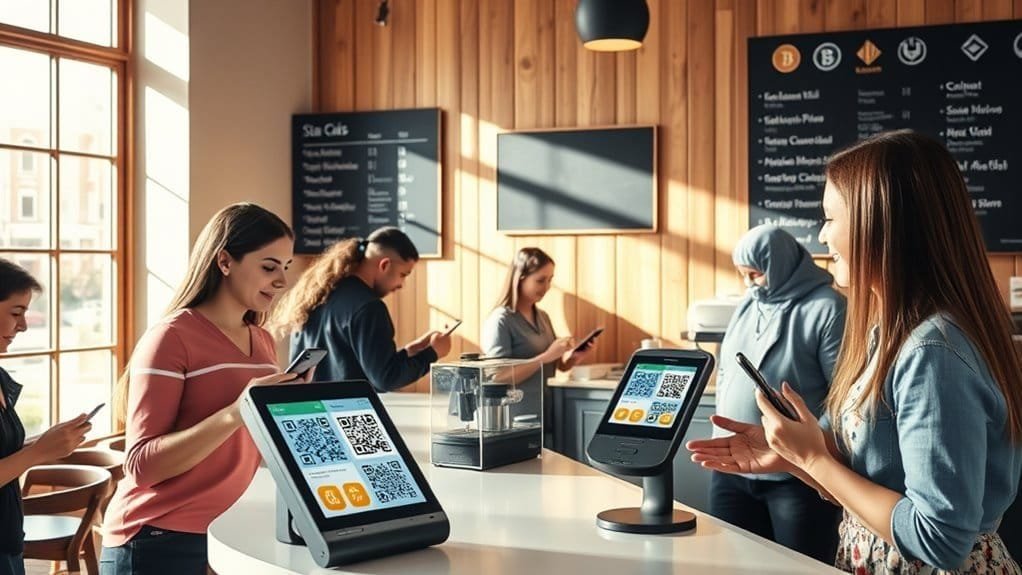The digital revolution in payments is transforming how small businesses operate. As customers demand seamless, secure, and cost-effective transaction options, digital currency payments have emerged as a key differentiator.
By understanding and adopting these future trends, small business owners can reduce fees, expand into international markets, and boost their competitive edge.
This guide breaks down the emerging trends in digital currency payments—from stablecoins and central bank digital currencies (CBDCs) to blockchain integration and AI‑driven optimization, and Bitcoin.
Whether you’re new to the concept or looking to upgrade your existing system, this comprehensive resource provides actionable insights that are hard for Google (and your customers) to ignore.
For additional background on crypto payment systems, check out our Crypto Payment Platforms for Small Businesses guide.
What You Will Learn
- Increased acceptance of cryptocurrencies among small businesses will improve cash flow and attract tech-savvy customers.
- Integration of BNPL services with digital currencies will enhance customer satisfaction and sales.
- Enhanced security measures, including biometric authentication and encryption, will build trust in digital currency transactions.
- The rise of real-time payment systems will facilitate faster transactions, crucial for small business cash flow.
- AI-driven fraud monitoring will become essential as digital currency adoption grows, ensuring transaction safety.
Benefits and Challenges for Small Businesses
Benefits
- Cost Reduction:
Digital payments generally incur lower fees than traditional banking methods. Reduced transaction fees can significantly lower your operating costs, allowing you to reinvest savings back into your business. - Global Accessibility:
With digital currency payments, geographic boundaries no longer limit your customer base. This opens up opportunities to attract international customers who may prefer or require digital payment methods. - Increased Security:
The inherent security of blockchain technology minimizes fraud and unauthorized transactions. This security builds trust with your customers and protects your revenue streams. - Operational Efficiency:
Automation through AI and blockchain reduces manual processing and administrative overhead, leading to faster transactions and smoother operations. This efficiency is especially critical for small businesses with limited resources. - Future-Proofing Your Business:
Adopting digital currency payments early positions your business as innovative and adaptable. It signals to both customers and search engines that you’re committed to staying at the forefront of technology.
Challenges
- Regulatory Uncertainty:
Digital currencies are subject to evolving regulations that can vary significantly by region. Small businesses must stay informed and agile to adapt to new compliance requirements. - Technical Integration:
Implementing a digital payment system may require significant upfront investment in technical infrastructure and training. Small businesses need to weigh these initial costs against long-term benefits. - Volatility Risks:
While stablecoins mitigate volatility, other cryptocurrencies can be highly volatile. Businesses need strategies to manage price fluctuations, such as immediate conversion to fiat currency. - Security Concerns:
Despite robust blockchain security, digital systems are not immune to cyberattacks. Small businesses must invest in cybersecurity measures and ensure that their systems comply with best practices. - Customer Adoption:
Although digital currencies are growing in popularity, some customers may still be hesitant to use them. Educating your customer base and providing clear benefits is essential for broader adoption.
For a comprehensive view on overcoming these challenges, see our guide on How to Secure Cryptocurrency Transactions.
Key Trends in Digital Currency Payments
Stablecoins and CBDCs
Stablecoins are cryptocurrencies pegged to traditional fiat currencies like the US Dollar. They mitigate the volatility commonly associated with digital currencies, making them ideal for everyday transactions.
- Example: USDC and DAI offer predictable value, reducing risks for small businesses.
- External Link: Learn more about the stablecoin market on CoinDesk.
Central Bank Digital Currencies (CBDCs) are digital forms of fiat money issued by central banks. They aim to combine the convenience of digital payments with the stability and trust of traditional currencies.
- Trend Impact: As more countries explore CBDCs, small businesses may soon have access to government-backed digital payment options.
- External Link: Explore insights on CBDCs from the Bank for International Settlements.
Blockchain Integration at the POS
Blockchain integration at the point of sale (POS) is revolutionizing how transactions are recorded and verified. By embedding blockchain technology into your POS system, you benefit from:
- Immutable Transaction Records: Every transaction is recorded on a decentralized ledger, reducing fraud.
- Increased Transparency: Both merchants and customers can verify transactions in real time.
- Reduced Disputes: The decentralized nature minimizes chargebacks and fraudulent claims.
For a deeper dive into how blockchain enhances transaction security, check out our How to Secure Cryptocurrency Transactions guide.
Multi-Currency and Global Reach
Supporting multiple digital currencies can help small businesses tap into a global market. With real-time currency conversions and multi-currency support:
- Global Expansion: Attract international customers without the hassle of traditional cross-border fees.
- Localized Payment Options: Tailor your payment system to the specific currencies and preferences of different regions.
Integrating multi-currency support is a key step toward expanding your digital footprint. For more information on managing international payments, refer to Cryptocurrency for International Payments.
Enhanced Security and Fraud Prevention
Security is paramount when handling digital payments. Emerging trends in digital currency payments focus on:
- Advanced Encryption: Leveraging blockchain’s decentralized nature to secure data.
- Multi-Factor Authentication (MFA): Adding additional layers of security to verify transactions.
- AI-Powered Fraud Detection: Implementing machine learning to monitor and flag suspicious transactions in real time.
For a detailed look at security best practices, visit How to Secure Cryptocurrency Transactions.
AI‑Driven Payment Optimization
Artificial intelligence is transforming payment processing by:
- Analyzing Transaction Data: AI systems can identify patterns and optimize fee structures.
- Predictive Maintenance: Machine learning algorithms forecast network congestion and adjust parameters accordingly.
- Personalizing Customer Experience: Tailor payment options based on customer behavior and preferences.
External Link: Discover how AI is being used in payment processing by exploring insights on Coinbase.
Emerging Digital Wallet Trends

As digital payments continue to evolve, I can’t help but notice the exciting trends emerging in digital wallets. These wallets are becoming safer and smarter. They use something called tokenization, which means they hide your real information when you buy something. This keeps your details safe.
Biometric authentication, like your fingerprint or face, guarantees only you can access your wallet. They also use high-level encryption to protect your data. Multi-factor authentication adds another layer of safety, making it harder for anyone to sneak in. Plus, AI watches for bad activities. With these features, digital wallets are making payments simpler and safer. As we see a surge in contactless payment adoption, users are increasingly embracing the convenience of digital wallets in everyday transactions. So, when using digital wallets, you can feel secure about your money and personal information.
The Shift to Faster Payments
Digital wallets are clearing the path for a significant shift toward faster payments, which is becoming increasingly crucial for businesses today.
Many small businesses want quick payments because it helps them manage money better. Faster payments mean businesses can get their money right away. This improves cash flow and keeps customers happy. In fact, 79% of small businesses desire more payment options from financial institutions, highlighting the growing demand for speed and efficiency.
Right now, not many businesses use real-time payments, but that’s changing. With new tools like FedNow and RTP, more businesses can join in.
It’s vital to pick a bank that offers these speedy options. If your bank doesn’t keep up, you might want to look for a better choice.
Faster payments can help your business grow and stay strong in a busy market.
Cryptocurrency Acceptance in Business

While many businesses are still adjusting to the rapid evolution of payment methods, accepting cryptocurrency can offer significant advantages.
Initially, it can lower processing costs compared to regular card payments. This means more money stays in your pocket. Accepting crypto can also meet customer preferences, attracting more people to your business.
Plus, you’ll enjoy faster fund settlements, which helps your cash flow. Cryptocurrencies can reduce fraud risks, making your financial transactions safer. Additionally, with 28% of American small businesses already accepting crypto, you could gain a competitive edge. To start, consider using a third-party vendor to make the process easier.
Altogether, accepting cryptocurrency can be a smart move for your business.
Impact of BNPL Services
The rise of Buy Now, Pay Later (BNPL) services has altered how small businesses approach sales and customer engagement. With BNPL, customers can buy items now and pay later, which enhances sales. When businesses use BNPL, they get full payment right away, improving cash flow. This means they can focus on running their business instead of worrying about collecting payments. BNPL appeals to younger demographics and allows small businesses to cater to a broader audience. Customers often buy more when they don’t have to pay everything at once, which increases the average order value. Offering BNPL makes customers happier and helps small businesses stand out from competitors.
Enhancing Security Measures

As security concerns grow in the domain of digital currency payments, businesses must prioritize enhancing their security measures to protect both their customers and themselves.
Start by adopting secure payment gateways that use strong security protocols like two-factor authentication and advanced encryption. This helps keep out bad guys. Additionally, the implementation of strict Know Your Customer (KYC) protocols can prevent illicit activities and enhance overall security.
Make certain your systems work well together to avoid hiccups for users. Regularly check your systems for weaknesses and train your staff on safety rules.
You should also follow significant laws to keep everyone safe, like getting user consent before using their data.
Lastly, consider using new technologies like blockchain and biometric methods to make payments even safer. Staying proactive in these areas will guarantee a secure experience for everyone.
Preparing for the Future
Small businesses can prepare for the future of digital currency payments by taking proactive steps:
- Staying Informed:
Regularly follow industry news and regulatory updates from sources such as CoinDesk and the Bank for International Settlements. This helps you anticipate changes and adjust your strategy accordingly. - Investing in Secure Infrastructure:
Upgrade your payment systems by integrating secure, scalable solutions. Consider platforms that offer robust API integration and support multi-currency transactions. For inspiration, review our Crypto Payment Platforms for Small Businesses. - Leveraging AI Tools:
Implement AI-driven analytics to optimize transaction processes and personalize the customer experience. AI can help identify cost-saving opportunities and reduce the risk of fraud. - Training Your Team:
Ensure that your staff is well-versed in new payment technologies and security protocols. Regular training sessions and workshops can bridge knowledge gaps and improve system efficiency. - Enhancing Customer Education:
Create clear, accessible content that explains the benefits of digital currency payments. Blog posts, FAQs, and video tutorials can help demystify the technology for your customers. For additional ideas, see our Guide to Securing Cryptocurrency Transactions. - Adopting a Phased Approach:
Start with basic implementations, such as accepting one or two stablecoins, and gradually expand as your business scales. This allows you to manage risks and costs while gaining experience.
Case Studies and Expert Opinions
Case Study: A Local Retailer Expands Globally
Consider a local retailer that implemented a digital currency payment system to cater to international customers. Initially, the retailer adopted stablecoins to minimize volatility and integrated a user-friendly payment gateway. Within six months, the business observed:
- A 30% increase in international orders.
- Reduced transaction fees by 40% compared to traditional payment methods.
- Improved customer satisfaction due to faster and more secure transactions.
This case study highlights how digital currency payments can drive global growth and operational efficiency for small businesses.
Expert Opinion: The Future is Hybrid
Industry experts believe that the future of digital payments will be hybrid, combining traditional methods with digital currencies. For example, Coinbase and other leading platforms are already exploring ways to bridge fiat and crypto transactions seamlessly. Experts emphasize the need for small businesses to adopt a flexible strategy that can evolve with technological advancements and regulatory changes.
Panel Discussion Insights
In a recent webinar organized by a leading digital marketing agency, experts discussed the following points:
- Integration of DeFi: Decentralized finance protocols will offer small businesses innovative financing options.
- Expansion of Mobile Wallets: With increasing smartphone adoption, mobile-optimized crypto wallets will be crucial for capturing on-the-go transactions.
- Importance of Data Analytics: Advanced analytics and AI will help businesses refine their payment processes, forecast trends, and reduce operational risks.
For further insights, consider watching webinars on digital currency trends from platforms like BigCommerce.
Frequently Asked Questions
How Can Small Businesses Educate Customers About Digital Payment Options?
I believe small businesses can educate customers about digital payment options by simplifying language, providing clear guides, and using engaging tools like videos. It’s crucial to make information accessible and encourage open communication for safety and understanding.
What Are the Potential Tax Implications of Accepting Cryptocurrencies?
Did you know that 70% of crypto users are concerned about tax compliance? When I accept cryptocurrencies, I make certain I track fair market values and report gains accurately to avoid costly penalties and stay safe financially.
How Do Different Digital Wallets Compare in Terms of Fees?
When I compare digital wallets, I notice fees vary considerably. Apple Pay’s no merchant fees attract me, while others like PayPal can be costly. I always consider how these fees affect my bottom line for safety’s sake.
What Infrastructure Is Needed to Implement Digital Currencies Effectively?
In terms of implementing digital currencies effectively, I’ve found that solid infrastructure, like secure wallets and decentralized networks, is key. It’s a tall order, but with the right measures in place, it’s doable.
How Can Small Businesses Measure the Success of Digital Payment Adoption?
To measure success with digital payment adoption, I track revenue growth, customer satisfaction, and operational efficiency. I also monitor transaction security and integration, ensuring my business runs smoothly and customers feel safe during their transactions.
Conclusion
Digital currency payments are rapidly transforming the way small businesses operate. By keeping pace with emerging trends—such as stablecoins, blockchain integration at the POS, multi-currency support, enhanced security measures, and AI-driven payment optimization—small businesses can unlock new opportunities for growth and competitiveness.
Preparing for this future involves staying informed, investing in secure and scalable infrastructure, leveraging advanced technologies, and educating both your team and customers. Early adoption of digital currency payment systems not only reduces operational costs and increases security but also positions your business as innovative and adaptable in a rapidly evolving marketplace.
For more actionable insights on digital payments and security, explore our related guides on How to Secure Cryptocurrency Transactions and Crypto Payment Platforms for Small Businesses.

